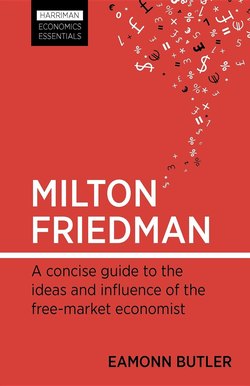Читать книгу Milton Friedman - Eamonn Butler - Страница 19
На сайте Литреса книга снята с продажи.
The monetary theorist
ОглавлениеTo Friedman, economics is about making accurate predictions, not about refining elegant mathematical models. Economists should aim to understand the big economic issues of the day, test their theories against the facts, and so find solutions that improve people’s lives. It may have been this idea that drew him to the fight against inflation – a particularly big problem in the postwar years – and to the economic theory with which he is most strongly associated, the quantity theory of money. He saw the quantity of money in circulation as a powerful predictor of future prices, and therefore a powerful tool for combating inflation.
Keynesians – that is, nearly all of Friedman’s professional contemporaries before the 1980s – dismissed the quantity theory as outdated and crude. At its crudest, it runs like this: governments control the amount of money in their country’s economy by printing new banknotes and minting new coins. If they print or mint a lot more currency, then – like anything that suddenly becomes more plentiful – its value falls. Producers then demand more pounds or more dollars for their goods and services, because they now value those notes and coins less. In other words, prices rise. We call this inflation, and its cause is a rise in the quantity of money. Control the production of money, and you control inflation.
Friedman did not invent the quantity theory; it had been around for centuries. But mainstream economists attributed price rises to other causes – the rising cost of oil or food imports, for example. And even if the quantity of money did increase, they thought, people might not spend it; perhaps it would just sit in their wallets or bank accounts, where it had no effect on the economy or prices at all – Keynes’s famous ‘liquidity trap’.
By the mid-20th century, the quantity theory seemed dead and buried; but it was not. In a 1956 article, ‘The Quantity Theory of Money: A Restatement’, Friedman brilliantly revived it. The theory’s power to predict inflation hinged not on the supply of money from governments, but on the demand for that money from consumers – the amount that people actually choose to keep readily to hand. Friedman proved that this demand is surprisingly stable. If extra money is created, it does not languish unused in people’s wallets or bank accounts: consumers actually keep a pretty constant amount of cash to hand. Any extra, they spend; and it is this extra spending that bids up prices. The quantity theory really does explain inflation.
Friedman’s 1962 A Monetary History of the United States, co-authored with Anna Jacobson Schwartz, demonstrated the impact of money on inflation in enormous detail. It furnished a fine example of the role of money in inflation: during the American Civil War, the South suffered huge price rises – which ended abruptly after Northern troops captured the presses that printed the South’s money. It also showed that the Great Depression, a time of dramatic price falls, stemmed not from any inherent instability of capitalism, but from the US Federal Reserve’s inept constriction of the supply of money.
“During the Civil War the North, late in the Civil War, overran the place in the South where the printing presses were sitting up, where the pieces of paper were being turned out. Prior to that point, the South had a very rapid inflation. If my memory serves me right, something like 4% a month. It took the Confederacy something over two weeks to find a new place where they could set up their printing presses and start them going again. During that two-week period, inflation came to a halt. After the two-week period, when the presses started running again, inflation started up again. It’s that clear, that straightforward.”
– Milton Friedman, Free to Choose, Episode 9
